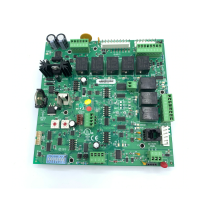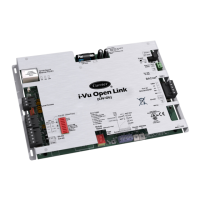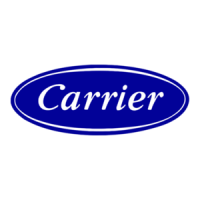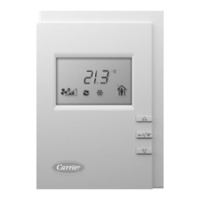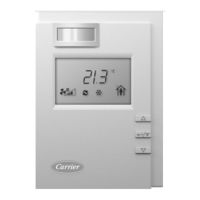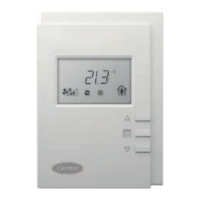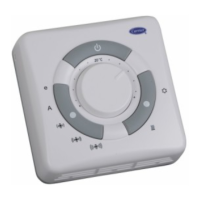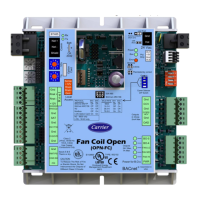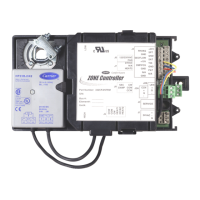24
If the above conditions are true, the Economizer control will
calculate a damper position starting with a minimum vent posi-
tion and based on current space temperature and a setpoint that
is one degree less than the effective cool setpoint. If the SAT
drops below the cooling low supply air setpoint (+ 5°F), the
economizer will close as required but not to less than the to
minimum position. The Calculated Min Econ Pos used for con-
trol is displayed in the Maintenance section.
The RTU Open controller provides Fault Diagnostic and De-
tection (FDD) for economizer operation in compliance with
California Title 24. The FDD logic will detect an economizer
that fails to close, fails to open, stuck fully open, and fails to
fully open. Each condition will cause an Economizer Operation
alarm to occur and the specific condition will be displayed.
Enthalpy Control
You may use an enthalpy switch to indicate the suitability of
outdoor air for economizer cooling. You can use either an out-
door air or differential enthalpy switch. A differential enthalpy
switch has a sensing device in both the outdoor and return air
streams. A differential enthalpy switch indicates when outside
air is more suitable to be used than the return air and is avail-
able for economizer cooling. If no enthalpy switch is config-
ured, a network point (Object Name: oae) is available. This
point is displayed in the i-Vu
®
application and Equipment
Touch™ as Enthalpy (BACnet).
The sequence of operation for economizer cooling is the same
with or without an enthalpy switch, except that an enthalpy
switch imposes one more validation on the suitability of out-
side air for economizer cooling. An Enthalpy Status that is
High disables the economizer and the outside air damper goes
to its minimum position. An Enthalpy Status that is Low en-
ables the economizer if a call for cooling exists and the remain-
ing preconditions are met.
Space Air Quality
Space Air Quality (AQ) is controlled on rooftop equipment us-
ing the economizer. The Space AQ sequence utilizes an air
quality (CO
2
) sensor to monitor conditions within the occupied
space. A CO
2
sensor may be terminated at the RTU Open con-
troller, or a subordinate zone controller, when part of a zoned
system.
An outdoor air quality sensor may also be installed and termi-
nated at the RTU Open controller, but is not required. When an
outdoor air quality sensor is not installed, the algorithm uses
400ppm as the fixed outdoor air CO
2
level.
The following conditions must be true for the Space AQ
algorithm to operate:
• The system is occupied
• The supply fan has been operating for at least 30 seconds
• The Space AQ sensor has a valid reading
As the air quality in the space decreases (Space AQ CO
2
value
increases), the minimum position of the economizer increases,
allowing more outdoor air to enter the space. The amount of in-
crease depends on the relationship between the Space AQ level
and the DCV Max Ctrl Setpoint.
The Space AQ algorithm calculates a minimum position value
using a PID loop. The CO
2
minimum damper position is then
compared against the Vent Dmpr Pos / DCV Min Pos setpoint
and the greatest value becomes the minimum damper position
utilized for the economizer. When the minimum economizer
position is being reset by the Space AQ algorithm, the System
Mode displays IAQ Override.
The maximum amount the economizer may be opened to out-
door air by the Space AQ algorithm is limited by the DCV Max
Vent Damper Pos, which is adjustable between 10 and 75%.
Power Exhaust
The RTU Open controller may enable and disable an exhaust
fan based on either the controller's occupancy or its economiz-
er damper position. If configured for continuous occupied op-
eration, it will be energized whenever the controller is in the
occupied mode and disabled when in the unoccupied mode. If
configured for damper position control, it will be energized
whenever the economizer exceeds the power exhaust setpoint
and disabled when the economizer drops below the setpoint by
a fixed hysteresis of 10%. If the Fan Control is set to Two
Speed or Variable Speed, the Power Exhaust Setpoint is auto-
matically adjusted based on the fan's air delivery. The Calculat-
ed PE Setpoint used for control is displayed in the Maintenance
section.
Pre-Occupancy Purge
Pre-Occupancy Purge allow the rooftop equipment with an
economizer damper to utilize outdoor air to purge the space of
contaminates just prior to the beginning of the occupied period.
• The following conditions must be true for pre-occupancy
purge to operate:
• Pre-Occupancy Purge set to Enable
• Economizer Exists set to Yes
• The local time schedule is currently unoccupied and the
remaining time is less than the configured Purge Time
When the RTU Open controller schedule is unoccupied and the
remaining unoccupied time is less than the purge time, the sup-
ply fan starts. The economizer damper opens to the configured
Economizer Purge Min Pos. The RTU Open controller contin-
ues to operate in this mode until the occupied start time is
reached. The Pre-Occ Purge state is displayed in the Mainte-
nance section.
Heating
The heat outputs are controlled by the Heating Control PID
Loop and Heating Stages Capacity algorithm. They will be
used to calculate the desired number of stages needed to satisfy
the space by comparing the SPT to the Occupied Heat Setpoint
the T56 slider offset when occupied and the Unoccupied Heat
Setpoint plus the T56 slider offset if unoccupied. The follow-
ing conditions must be true in order for this algorithm to run:
• Indoor Fan is ON for any unit with electric heat.
• Cool mode has not been active for 5 minutes.
• If occupied and SPT <(occupied heat setpoint plus T56
slider offset)
• SPT and supply air temperature values are available
• If it is unoccupied and the SPT < (unoccupied heat setpoint
plus T56 slider offset).
• OAT < High OAT lockout temperature.
If all of the above conditions are met, the controller uses a PID
logic loop to energize or de-energize heat outputs to satisfy the
heat demand. If the SAT begins to exceed the high supply air
setpoint, a ramping function will cause the Heat Stages Capac-
ity algorithm to decrease the number of stages until the SAT
has dropped below the setpoint. There is a fixed one minute
minimum on time and a one minute off time for each heat out-
put. There is a 10 minute minimum stage up delay if the heat
demand is ≤ 3°F, and a 2 minute minimum stage up delay if
heat demand is > 3°F.
When set for Variable speed, the Supply fan output will start
with the Heating VFD Output/IDF Heat Speed Voltage and
ramp up as needed if the SAT approaches the Maximum SAT
setting.
Indoor Air Quality
If the optional indoor air quality sensor is installed, the RTU
Open controller will maintain indoor air quality within the

